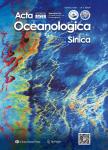Heterocapsa bohaiensis ***.(Peridiniales:Dinophyceae):a novel marine dinoflagellate from the Liaodong Bay of Bohai Sea,China
Heterocapsa bohaiensis sp. nov.(Peridiniales:Dinophyceae):a novel marine dinoflagellate from the Liaodong Bay of Bohai Sea, China作者机构:Key Laboratory of Science and Engineering for Marine Ecology and Environmentthe First Institute of OceanographyState Oceanic AdministrationQingdao 266061China Laboratory for Marine Ecology and Environmental SciencePilot National Laboratory for Marine Science and Technology(Qingdao)Qingdao 266237China Guanghe Crab Industry Limited CompanyPanjin 124200China School of Food and EnvironmentDalian University of TechnologyPanjin 124221China
出 版 物:《Acta Oceanologica Sinica》 (海洋学报(英文版))
年 卷 期:2018年第37卷第10期
页 面:18-27页
核心收录:
学科分类:0710[理学-生物学] 071001[理学-植物学] 0908[农学-水产] 07[理学] 0707[理学-海洋科学]
基 金:The NSFC-Shandong Joint Funded Project under contract No.U1406403 the National Natural Science Foundation of China under contract Nos 41506191 and 41306171
主 题:Heterocapsa harmful algal bloom thecal plate body scale ITS
摘 要:A small armed dinoflagellate bloomed in the aquaculture ponds off the coast of Liaodong Bay, Bohai Sea of China, resulting in heavy mortalities of the cultured prawns (Penaeusjaponicus) and larvae of Chinese mitten handed crabs (Eriocheir sinensis). The bloom-forming species was successfully isolated, and cellular morphology of the specimen was consequently investigated through light, fluorescent and electron microscopy. The small ((14.4±1.6) μm in length) ellipsoid cells show typical Heterocapsa thecal plate arrangement (Po, cp, 5′, 3a, 7″, 6c, 5s, 5′″, 2″″). The episome is evidently bigger than the hyposome. One to three spherical pyrenoids are located above or beside the large elongated nucleus. The body scale is characterized by a triangle basal plate with one central upright and nine peripheral spines. Above all, Heterocapsa bohaiensis could be distinguished from other Heterocapsa species by the combination of the cell size, morphology, cellular structure and body scale. Sequence analyses of both ITS and LSU regions reveal the significant genetic divergence between H. bohaiensis and other established species in this genus, further supporting novelty of this species. Noticeably, different sample treatment methods resulted in morphological variation of the apical pore complex (APC) of H. bohaiensis, which needs to be taken into account in future study.



